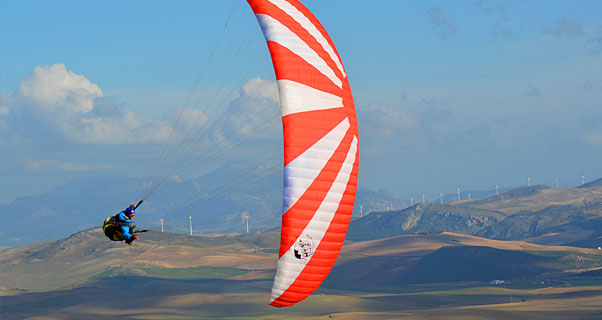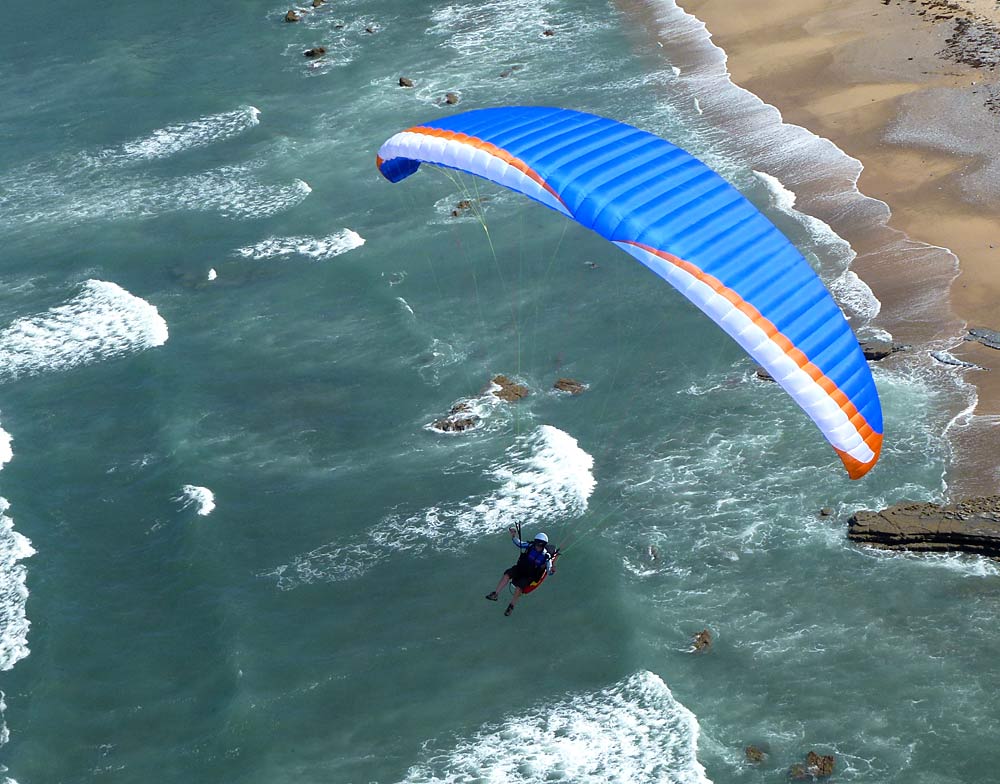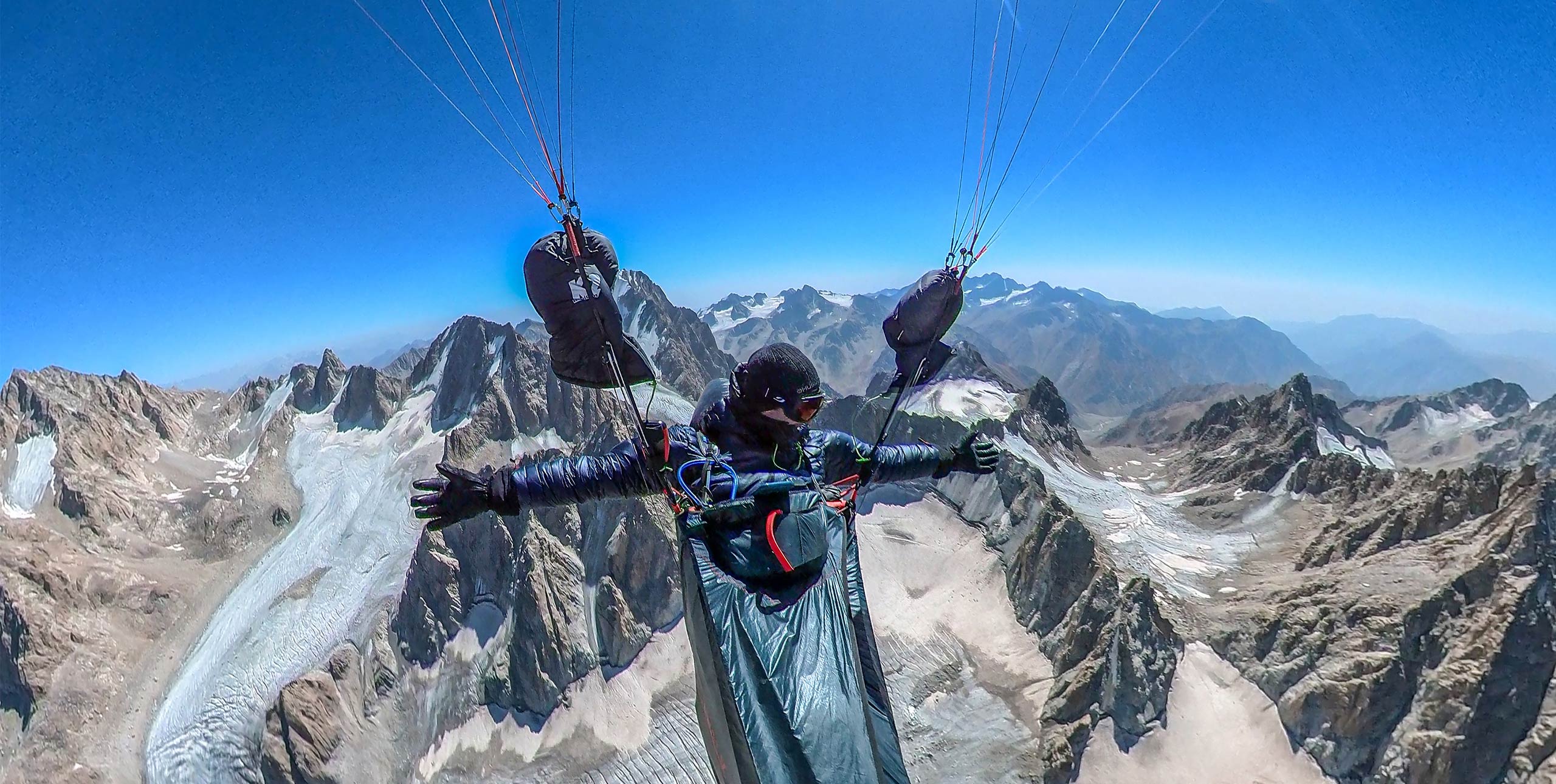The only video clip of the Windtech Pulsar we could find…
‘Pulsar’ is the name given to any cluster of small, energetic stars that rotate fast and emit energy. Translated into paraglider design, this could be well be the recipe for a pocket rocket. Jaco Wolmarans checks out Windtech’s new DHV 1/2 Serak replacement to see if the name fits. Published in Cross Country magazine in 2004
THE BRIEF
Windtech has recently sprung to the foreground with a spate of headline-grabbing records made on their latest wings. Factory pilot Josh Cohn recently broke the declared goal world record with a flight of 307 km on his DHV 2 Quarx and also flew a declared goal flight of 177 miles on the Nitro competition wing.
This is the lineage of the new Pulsar, and before it, of the Serak, which Windtechs Matt Taggart described in 2001 as “a DHV 1-2 with the performance of the Quarx or Bagheera”. The Serak indeed turned out to be a hugely successful wing, and has long been regarded as one of the higher performers in this class. But the time has come for a change.
Windtech designer and co-owner, Alvaro Valdés, thus had a hard act to follow with the Pulsar, especially if he was to attain what Matt reckoned was about to become the focus of designers world-wide – optimising the wing for glide and stability at speed.
Alvaro says the Pulsar is based on the experience hes gained from all his previous models: parasitic drag has been reduced to a minimum, with internal V-ribs of varying size allowing for economical placement of the suspension lines.
The result is more speed while the wing maintains its structural integrity and stability in turbulence – perfect for a DHV 1-2 glider. “The technical details and specifications are similar to the earlier gliders but optimised in progressive stages at all levels,” he says.
My first flight was enough to convince me that the Pulsar has indeed been “cleaned up”: it showed both good speed and good glide at speed.
CONSTRUCTION
The Pulsar comes in an attractive three-colour livery and is made from lightweight and crinkly Nylon – specifically, Porcher Marine Skytex (45 g/m2). It sports 1.1 and 1.7mm Kevlar lines and nice, thick, chunky risers at the harness end.
In a word, the construction is faultless, with beautifully regular stitching throughout. Alvaro says the profile thickness, cell width and chord line of the Pulsar are unique throughout the span, starting at the centre of the wing and graduating to the wing tips with varying sizes and lengths.
By using their proprietary design software and clever construction to avoid external stitching Windtech have produced an aerodynamically clean wing.
All this fits into an attractive bag of a somewhat unusual design: the top section is a separate bag that folds over the body of the bag. Note that youre unlikely to fit your harness and glider into the bag unless you pack the harness upside down.
LAUNCHING
In gentle conditions, the lightweight Skytex fabric makes for ridiculously easy launches. Forward launches are a breeze: simply leaning forward and using your weight is enough to bring the glider overhead.
It doesnt hang back just short of top dead centre in lighter conditions either, which makes it easy to launch under paramotor power as well.
Like the Ozone Vibe, the wing tends to be rather over-enthusiastic in strong conditions and shoots up quite fast, but a quick check on the brakes will stop it dead overhead.
Still, in “normal” flying conditions of 10-15km/h winds, the Pulsar is perfectly predictable. So much so that I managed an effortless reverse pull-up with no hands on the risers, and the brakes clipped in – just by leaning back.
Even in this configuration, and without it being checked overhead, the Pulsar stopped above me by itself, allowing me to turn and run down the hill while reaching up to unclip the brakes. This is on par with the beautiful launch characteristics I experienced on the new Firebird Grid.
Ground-handling is very direct. The wing responds well to input and quickly corrects itself assisted by a little bit of sideways footwork.
PERFORMANCE AND HANDLING
The Pulsar’s directness during ground-handling is a precursor of its airborne characteristics: direct, solid, and very responsive. Initially I was convinced I was flying a higher-rated wing than a DHV1-2, such was the feedback but almost 20 flights later in sometimes dubious conditions, I had yet to experience a single collapse.
The Pulsar stalls at 21-22km/h, cruises at around 36km/h and musters a top speed of around 48km/h. I must confess, that at this speed, I ran out of leg length and still had 2cm speedbar travel left, which would account for Windtechs claim of 50km and a speed range of +14 km/h when you hit the go fast button.
Go fast it certainly does. I tested it on trim against the very quick ProDesign Effect I and an Ozone Octane and watched both recede in the rear view mirror. On full bar, it even smoked a DHV2 on glide at speed.
Alvaro says the Pulsar gets its speed from a combination of the internal construction and reduced total line length. It is rock-solid on both half and full bar. Glide at speed is not shabby either – a long glide out from Cape Towns Lions Head in coastal air gave me a mean sink rate of 2m/s at 48km/h.
This wing just loves to turn, brake response is instant, but, as is often the case with intermediates, height loss in steep turns can be substantial, especially in light conditions.
The Pulsar digs in and dives on command – so much so that being heavy-handed on the brakes will quickly make you catch your breath. Spirals are the same – immediate and deep.
That’s why the wing is not aimed at the entry-level pilot. In light conditions, going gently on both brakes and using some subtle weight-shifting did result in a respectable sink rate in turns. You just have to be delicate and keep a little brake on the outside as well.
Thermalling is where the Pulsar really comes into its own – that beautiful turning ability allows you to lock into the core so hard it sometimes feels like youre spinning backwards.
It shows little or no tendency to flatten off, or get rolled out of the core by strong lift. Because of its sensitivity, you feel every little nuance of the thermal. Initially this was quite disconcerting (for a DHV1/2) and felt rather like my FreeX Oxygen.
However, concern soon turned into joyous abandon once I realised the Pulsar could remain absolutely rock-solid throughout the steeper turns and exits from thermals.
During wing-overs, I noticed the same rigidity across the span of the wing. The glider failed to unload even during steep wingovers. This imparts a wonderful feeling of safety, especially so in turbulent air.
Alvaro says this is a product of several different factors: “The profile and the shape of the planform enable a better relationship between angle of incidence, aerodynamics and distribution of the pilots weight, and therefore it does not fold.”
I played a little game of chicken with the Pulsar to test its resistance to symmetric collapses. Allowing the wing to surge forward from point of stall without checking its dive brought it seemingly close to front tucking.
Every time, the Pulsar stayed nice and solid. I tried ignoring the surge to see if it would tuck, but must admit I repeatedly chickened out before the glider did and hit the brakes to damp the surge. The reaction again was immediate.
Asymmetrics are simply a joke. Pull the A-riser and the wing barely folds. Pull harder and … the wing barely folds. Put on a bit of speed bar, jerk hard and … hardly a crease. All very reassuring.
Its extremely hard to deflate the leading edge, and when you do succeed, the wing turns very little. Hats off to Windtech for high-end stability.
Comparing it to other wings in this class I’ve flown recently, it feels more responsive than the Gin Oasis, but has a similar stability, while in lightness in handling it compares with the Vibe.
On top speed it compares favourably with the Airwave Sport, and glide at speed probably exceeds the expectations of its class.
Although the Pulsar is not intended as a paramotor wing, a final flight before dispatching it back to Spain confirmed it to be ideally suited to the task with easy launching in light conditions, no discernable roll or yaw under climb, and heaps of speed.
Windtech in fact have used the Pulsar as the platform to develop their dedicated paramotor wing, the Kinetic. They say that the Pulsar is suitable for motor flight too if you can live without the special trimmers used on the Kinetic.
SUMMARY
Throw the Pulsar into a couple of energetic wingovers and youll quickly throttle back on your brake input with a new respect for its enthusiasm.
Rather like the Ozone Octane in this respect, it needs to be “under-steered” and demands a sensitive pilot. In fact, I would hazard a guess that it will make an extremely good acro wing, but Alvaro assures me he has even more agile wings in his current arsenal.
The Pulsar is a wing for the discerning pilot who will appreciate its fine-tuned abilities. It is suitable as a step-up glider, not an entry-level wing, and will make an ideal double-up motor and free-flying wing.
And, should you ever enter a competition on it, you can forget using the wing as an excuse for a poor result.
TECHNICAL DETAILS
Size 23 25 27 30
Weight Range (kg) 60-80 70-90 85-105 100-125
Area Flat (m2) 24.10 25.85 27.6 30.15
Area Projected (m2) 21.27 22.8 24.3 26.6
Span Flat (m) 11.12 11.52 11.9 12.44
Span Projected (m2) 9.22 9.55 9.86 10.31
Aspect Ratio Flat 5.13 5.13 5.13 5.13
Aspect ratio Projected 4 4 4 4
Cells 52 52 52 52
Glider Weight (kg) 7.2 7.47 7.68 8.3
AFNOR certification Standard
DHV certification 1-2 1-2 1-2
• Got news? Send it to us at news@xccontent.local. Fair use applies to this article: if you reproduce it online, please credit correctly and link to xcmag.com or the original article. No reproduction in print. Copyright remains with Cross Country magazine. Thanks
Subscribe to the world’s favourite hang gliding and paragliding magazine











